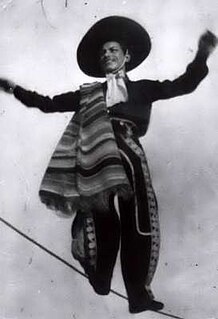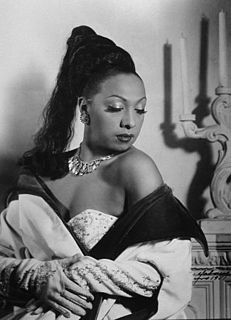Related Research Articles

Improvisational theatre, often called improvisation or improv, is the form of theatre, often comedy, in which most or all of what is performed is unplanned or unscripted: created spontaneously by the performers. In its purest form, the dialogue, action, story, and characters are created collaboratively by the players as the improvisation unfolds in present time, without use of an already prepared, written script.

Mario Fortino Alfonso Moreno Reyes, known by the stage name Cantinflas, was a Mexican comedian, actor, and filmmaker. He is considered to have been the most widely-accomplished Mexican comedian and is celebrated throughout Latin America and in Spain as a popular icon. His humor, loaded with Mexican linguistic features of intonation, vocabulary, and syntax, is beloved in all the Spanish-speaking countries of Latin America and in Spain and has given rise to a range of expressions including cantinflear, cantinflada, cantinflesco, and cantinflero.

A theater, theatre or playhouse, is a structure where theatrical works or plays are performed, or other performances such as musical concerts may be produced. A theatre used for opera performances is called an opera house. While a theater is not required for performance, a theater serves to define the performance and audience spaces. The facility is traditionally organized to provide support areas for performers, the technical crew and the audience members.

Astrid Hadad is a well-known Mexican actress and performance artist. She was born on February 26, 1957, Chetumal, Quintana Roo, Mexico. She attended the National Autonomous University of Mexico, originally planning to major in political science and journalism but then changing to theatre. After appearing in a number of shows, she came to the fore in 1985 in Donna Giovanni, an all-female adaptation of Mozart's opera, which was directed by Jesusa Rodríguez and became a great hit in Europe. It closed after its 500th performance, in the Palacio de Bellas Artes in Mexico City.
In Mexican society, pelado is "a term invented to describe a certain class of urban 'bum' in Mexico in the 1920s."

La Carpa García, known in English as the García Brothers Show, was a Mexican American carpa that was active from 1914 – 1947. Carpa García consisted of performers from several families, including Manuel V. and Teresa García, Manolo and Florinda García, Raymond and Virginia García, Rodolfo García, Consuelo and Pilár García, Esther García Robinson, Esperanza,, and Aida García Castro and husband, Alfredo. Teresa García also had three talented children, Rafael, Juan, and Gilberta, from her previous marriage.
Raúl Velasco Ramírez was the Mexican host/producer of the TV show Siempre en Domingo which is his hallmark contribution to the Latin American world and eventually to other parts of the world where Spanish entertainment programs are broadcast.

The Festival Internacional Cervantino (FIC), popularly known as El Cervantino, is a festival which takes place each fall in the city of Guanajuato, located in central Mexico.

Jesusa Rodríguez is a Mexican theater director, actress, performance artist, social activist and elected Senator of the Morena party.
Meche Barba, was an American-born Mexican film actress and dancer of the Golden age of Mexican cinema in the 1940s and 1950s. She was considered one of the icons of the "Rumberas film".

Cantinflas Show is a Mexican animated television series produced by Televisa. The series was created by Mario Moreno 'Cantinflas' and animated by Spanish animator José Luis Moro, who animated the pilot episode in 1972.
Rosita Fernández was a Mexican American Tejano music singer, humanitarian, and actress. She became a symbol of "Old Mexico" among European Americans in San Antonio, and was called the city's First Lady of Song by Lady Bird Johnson.She was known for her unique voice; it reminded many listeners of Old Mexico. She was born in Nuevo Leon, Monterrey Mexico she eventually moved to Texas. When she moved to San Antonio the Mexican Heritage became her strong influence for her music. In her career and life the city always was home to her due to its strong background to early Mexican Texans. The Mexican American History in the city gave her comfort to her roots from home and the city had strong spiritual connections to cultural traditions. Rosita began her singing career with her uncles group Trio San Miguel. They traveled tent shows in migrant paths in South and Central Texas. She got her voice in the radio for commercials and other forms of broadcasting programs. Rosita Fernandez would go on to eventually star in minor roles of Movies and Television, she will also sing for many other celebrities such as American presidents and the Mexico present. She was motivated by one quote “God gave me a voice that is pleasant to hear, and I want to share it.”[1] She was inducted into the San Antonio Musicians Hall of Fame, San Antonio Women's Hall of Fame, and the Tejano Music Hall of Fame, and received Woman of the Year honors in 1983. She has preformed publicly for over sixty years.
Arturo "Benito" Castro Hernández, is a Mexican musician, singer, songwriter, actor, imitator, most famous as a comedian, and as a member of Los Hermanos Castro.

A vedette is the main female artist of a show derived from cabaret and its subcategories of revue, vaudeville, music hall or burlesque. The purpose of the vedette is to entertain and captivate the public. The vedette has to know how to sing, dance and act on stage. Particularly accomplished artistes are considered super vedettes or first vedettes. Vedettes often appear alongside groups of dancers, flashy and revealing costumes, magicians, comedians, jugglers, or even performing animals. Vedettes specializing in burlesque generally do striptease and may also perform nude on stage.
The Plaintext Players were an online performance group founded by Antoinette LaFarge in 1994. Consisting mainly of artists and writers, they engaged in improvisational cyberformance on MOOs and later branched out into mixed reality performance, working with stage actors. Their performances form a "hybrid of theatre, fiction and poetry".
Triskelion Arts is a non-profit arts presenting organization founded in 2000, which includes two theaters and rehearsal studios in Greenpoint, Brooklyn. Triskelion Arts features artists from the concert dance, comedy, improvisation, Butoh and clowning communities, “where young companies can afford to self-produce and where choreographers can take a chance.” [3]

Comedy in the Golden Age of Mexican cinema is a Mexican film that was popular during "El Porfiriato" which represents the reign of Porfirio Díaz as dictator in Mexico.

OTI Festival 1974 is the third edition of the OTI Festival. It was held on October 26 in the Ruiz de Alarcón Theatre of the Mexican coastal city of Acapulco. The well-known television personality Raul Velasco and the journalist Lolita Ayala were the presenters of the event. This festival was marked by the debut of seven countries, which led to a sudden rise in the number of participating entries.

The OTI Festival 1976 is the fifth edition of the OTI Festival which was held on October 30 in the touristic coastal city of Acapulco, México, located in the Guerrero State. As happened two years before, the festival was held again in the Ruiz de Alarcón theatre of Acapulco and was presented, by the journalist Raúl Velasco, who presented the contest two years before, and by Susana Dosamantes, a well known Telenovela Actor.
El Corrido is a 1976 musical comedy made for TV film directed and written by Luis Valdez, and produced by El Teatro Campesino. The film was adapted from Valdez's stage musical La Gran Carpa de los Rasquachis, which was also produced with El Teatro Campesino. El Corrido was aired on PBS on November 4, 1976 as part of its Ballad of a Farmworker television series on the series Visions.
References
- ↑ "La carpa, el teatro, la imagen, la risa, la consagración". Proceso. 24 April 1993. Archived from the original on 14 February 2015. Retrieved 14 February 2015.Cite journal requires
|journal=(help) - ↑ Montijano Ruíz, Juan José (2012). El teatro chino de Manolita Chen. Madrid: Editorial Círculo Rojo. pp. 35–61. ISBN 9788499916613.